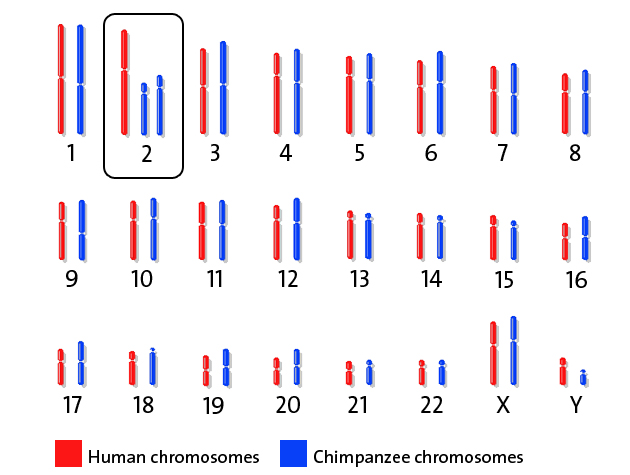It is known that humans, Neanderthals, and Denisovans all share 46 chromosomes. It is known this happened due to the merger of two chromosomes from an ancestor of Chimpanzees - the 2a and 2b chromosome from an ancestor of Chimps, humans, Neanderethals, and Denisovans had a mutation where these 2 chromosomes merged into one.
See here and here.
![]()
The problem though is this: if an individual was born with only 46 chromosomes, but all of their relatives in the same species had 48, how could they successfully mate? Crossing 46 chromosomes with 48 chromosomes will not successfully produce offspring (supposedly). So yes, a mutation could cause 2a and 2b to merge into 2 (which is what genetic analysis shows did happen) - but then how could the new being mate and produce offspring that also only had 46 chromosomes? "The Island of Doctor Moreau" is fiction.
It is possible to cross breed two closely related species, but supposedly the hybrid offspring is always sterile. For example, donkeys have 62 chromosomes and horses have 64 chromosomes. The resulting offspring is called a mule. Mules are sterile and cannot even breed with each other.
So here is the mystery: where did the original human ancestors come from? A mutated 46 chromosome offspring from a 48 chromosome chimp ancestor could not breed with chimps. And the odds of 46 chromosome "original human ancestor" finding another mutated 46 chromosome "original human ancestor" are massively unlikely, since the mutation of the merger of chimp ancestor chromosomes 2a and 2b into a single "original human ancestor" chromosome 2 would be extremely rare.
We know the mutation occurred. We know that human chromosome 2 was generated by the fusion of a chimp ancestor chromosomes 2a and 2b. But we don't know how that offspring found a mate that could be successfully bred.
It is a mystery.
See here and here.

The problem though is this: if an individual was born with only 46 chromosomes, but all of their relatives in the same species had 48, how could they successfully mate? Crossing 46 chromosomes with 48 chromosomes will not successfully produce offspring (supposedly). So yes, a mutation could cause 2a and 2b to merge into 2 (which is what genetic analysis shows did happen) - but then how could the new being mate and produce offspring that also only had 46 chromosomes? "The Island of Doctor Moreau" is fiction.
It is possible to cross breed two closely related species, but supposedly the hybrid offspring is always sterile. For example, donkeys have 62 chromosomes and horses have 64 chromosomes. The resulting offspring is called a mule. Mules are sterile and cannot even breed with each other.
So here is the mystery: where did the original human ancestors come from? A mutated 46 chromosome offspring from a 48 chromosome chimp ancestor could not breed with chimps. And the odds of 46 chromosome "original human ancestor" finding another mutated 46 chromosome "original human ancestor" are massively unlikely, since the mutation of the merger of chimp ancestor chromosomes 2a and 2b into a single "original human ancestor" chromosome 2 would be extremely rare.
We know the mutation occurred. We know that human chromosome 2 was generated by the fusion of a chimp ancestor chromosomes 2a and 2b. But we don't know how that offspring found a mate that could be successfully bred.
It is a mystery.